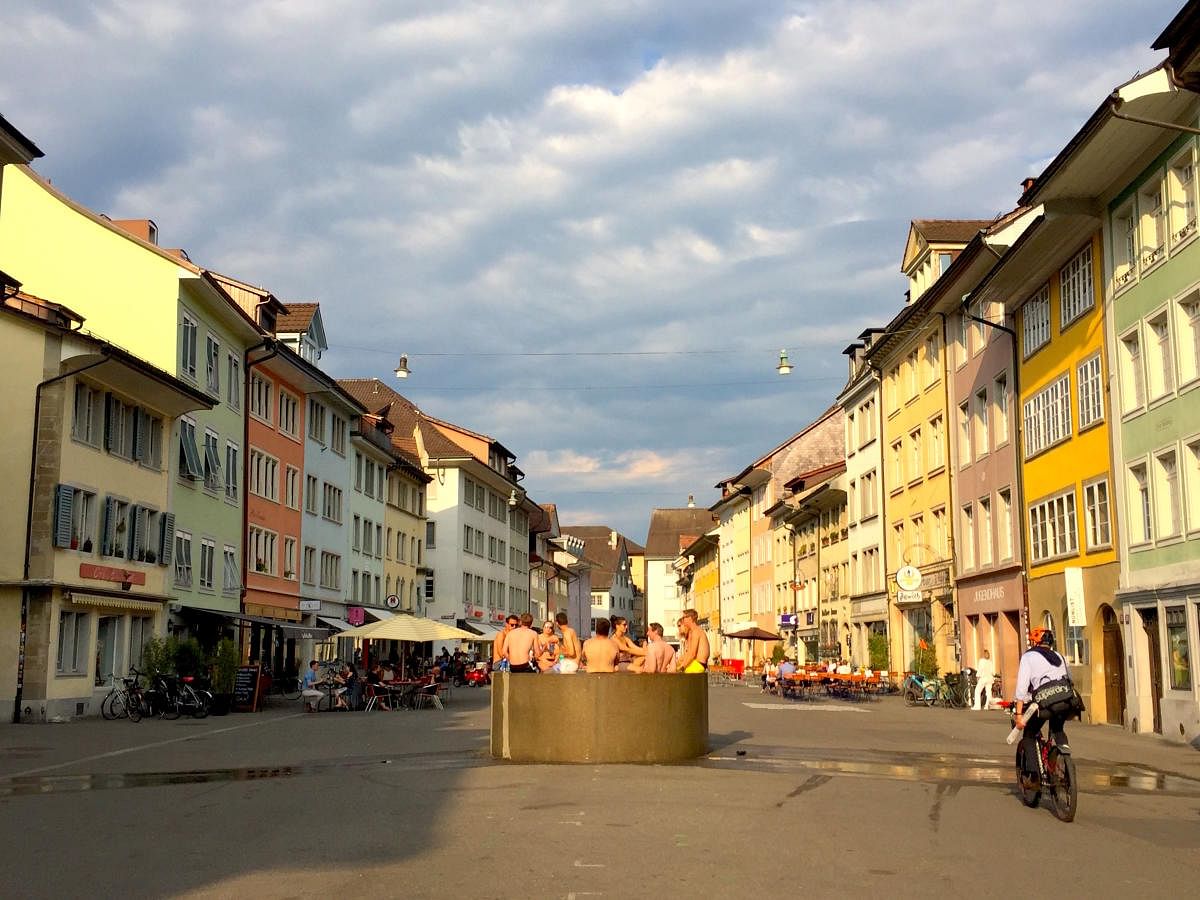
Winterthur is more than just a day visit from Zürich. A Swiss city northeast of Zurich, near the German border, it has museums including the Fotomuseum Winterthur, with its photography exhibits, and the Swiss Science Center Technorama and the Museum Oskar Reinhart that shows artworks from antiquity to the 1900s. Kunstmuseum Winterthur exhibits modern art, including Picasso and Klee. The Rosengarten is a hilltop garden with hundreds of rose varieties and views of the old town.
Winterthur, Switzerland’s sixth largest city, does not show as prominently on its tourist map as many others do. Only 20-minutes by train from the country’s economic city, Zürich, Winterthur is popular with locals who come here to work and study. The foundation of Switzerland’s first chemical factory in 1775 was laid in Winterthur. It is also where the large industrial firms — Rieter spinning mill in 1812, Sulzer foundry in 1834 and Swiss Locomotive and Machine Works in 1871 — flourished. Only after a period of recession, around 1975, the city changed its industrial outlook to thrive with culture and education. Winterthur is teeming with disciplined professionals and enthusiastic college students. But what about tourists who would like to explore the city?
Largest science centre
Marvel at the Swiss Science Center Technorama, which is one of the largest science centres in Europe. This interactive science centre is spread over two floors and has different exhibitions on physics, chemistry, biology with a gamut of presentations, workshops and open laboratories. Technorama’s primary aim is to encourage people to touch and play with their scientific projects on display. The most fascinating and inspiring is Magneticity exhibition on the ground floor and then water, nature, chaos on the first. While this science centre is evidently loved by children, there are many adults who completely immerse themselves in a project or two. Even though Technorama can take all day, a visit to the grand Oskar Reinhart Collection Am Römerholz is a must. A little away from the city centre, this villa was once the house of Oskar Reinhart, an art lover and collector. The villa-turned-museum now houses exquisite paintings from
the personal collection of Reinhart (and his father). The galleries boast of European Impressionists like Pierre-Auguste Renoir, Claude Monet, Edouard Manet, Paul Cézanne, amongst others. It also has Francois Goya, Lukas Cranach, Vincent Van Gogh and Pablo Picasso’s work.
Return to the town for an indulgent meal at National on Stadthausstrasse. The centrally located European-Mediterranean restaurant is known for its veal. Trübli in the heart of the Old Town is a relaxed, charming restaurant. The terrace during summer is a great favourite with locals as is the bar and bakery specials.
Historic
Start the day early with a visit to the city’s historic buildings in Altstadt (or Old Town). This part of the town was made completely car-free in 1993. Stroll around to admire the architecture — Alte Kaserne (built in 1765 for the military, now used as a cultural centre); Haus zur Geduld (a Baroque house that finds its first mentions in 1448, now a club); Rathaus (or City Hall which is an example of Neoclassic architecture); Stadtkirche (a magnificent church whose choir dates back to 13th century) and Waaghaus (late Gothic construction of 1503). The weekly local market (held every Tuesday and Friday mornings) on Steinberggasse and Metzggasse is extremely charming. Many residents come out to buy (and sell) cheese, oils and dressings, breads and meat, flowers, fruits and vegetables and homemade ingredients like honey and wine.
Walk onwards to the central locale of industrial engineering that once flourished in Winterthur, Sulzerareal. This is in sharp contrast to the medieval Old Town. Sulzerareal was the site of former industries and laboratories, which has been now developed as a sustainable urban space. The steam engines and the rail road may have disappeared from here, but it has paved the way for designers, architects and artists. The Bohemian area, Lagerplatz (or warehouse district) has transformed into a cultural hub with trendy and fun places like Skills Park, which has various activities, workshops and sports.
Within Sulzerareal, The Wagons is a restaurant put together by renovating an original railcar from the bygone industry.Contemporary restaurants like Stricker’s, a very short walk away from Sulzerareal, hand-craft their menu every day for fresh and seasonal specials.
All things Swiss
Experience museum fatigue by visiting Museum Oskar Reinhart am Stadtgarten on Stadthausstrasse and Fotomuseum Winterthur on Grüzenstrasse. The former houses exquisite works of Swiss, German and Austrian painters. Local Swiss masters like Anton Graff, Arnold Böcklin and of course, Albert Anker grace its galleries.
Fotomuseum Winterthur has permanent exhibitions of master photographers from 19th and 20th century. Their current exhibitions keep changing and have displayed works by Magnum photographers like Gilles Peress. Kunstmuseum Winterthur (modern art) on Museumstrasse, Villa Flora (French paintings) on Tösstalstrasse, Naturmuseum on Museumstrasse, Gewerbemuseum Winterthur (museum of design) on Kirchplatz and Münzkabinett und Antikensammlung (museum of money and antiques) on Lindstrasse are only some of the 17 museums in the city.
As an alternative, take a two-hour trip to the neighbouring Schloss Kyburg (Castle Kyburg).
It is about 10 kilometres southwards from the city and the castle is believed to be 800 years old. It stands 150 metres tall over River Töss and has a majestic presence.
The museum in the castle narrates its history with various artefacts and pieces of information.